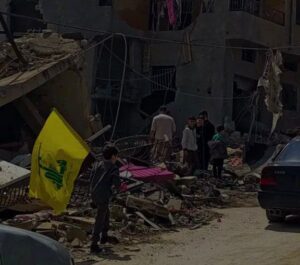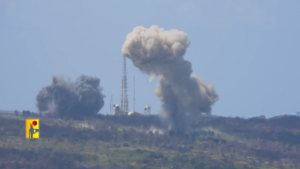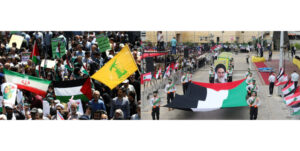With the war in Syria coming to an end, Syria’s allies, Russia and Iran, are planning to benefit from the support they have been providing the embattled country since 2015. The two countries are expected to gain significant revenue from investing in the reconstruction of Syria, a phase that is now underway. The aim of this article is to analyze the Iranian approach, attitude, and action in order to secure Iran’s interests in the region.
An alliance with Assad can yield numerous benefits for the Ayatollah regime. Hoping to secure a military stronghold, political influence, and future revenue from reconstruction activities, Iran is currently undertaking grassroots actions to increase its economic involvement in Syria and strengthen its relationship with the Syrian people.
A prominent example is Iran’s investment in the ground corridor extending from Teheran to Damascus. One of Iran’s most significant strongholds is located in Al-Boukamal, in the Dir a-Zour province, the lone official border crossing between Syria and Iraq that the Iranians can access. Here, Iran can transfer fighters and weapons as well as materials and equipment needed for reconstruction, including soil and cement. We believe, since the loss of ISIS near the Al-Boukamal border crossing, this practice has become only more frequent.
In addition, Iran, Iraq, and Syria are aiming to resume plans to link the three countries via railway—a project that was established prior to the war. Currently, there are four potential routes that may provide a direct, continuous road-link between Iran, Syria, and Lebanon.
The first is the northern route: Tehran-Mosul-Aleppo-Latakia passes through Kurdish-controlled territories and areas in Idlib Province. Therefore, it has been closed to Iranian free movement. The second is the middle route: Tehran-Baghdad-Al-Bukamal-Damascus-Beirut, which has been open since November 2017. But there are disturbances in the flow of traffic along the Syria-Iraq border. The third, the southern route: Tehran-Baghdad-Tanf-Damascus-Beirut, which is the shortest route. Because of the presence of the US military at the Tanf-Iraq border crossing, this route is presently closed at the mid-point. The fourth route mostly follows along the third route, though some parts travel farther south toward the Shiite regions of Iraq.
There have been multiple reports that Iraq, Syria, and Iran have signed an agreement to build a new 1,050-mile highway complex that would connect Tehran to Damascus. The Iranian Minister of Transportation, Muhammad Islami, stated that Iran has started to build the highway within its territory.
Education & Indoctrination
There is precedence to the Iranian policy of embedding its civilian grassroots efforts in Middle Eastern countries to gain military strongholds, especially within Shiite populations. The most prominent example is south Lebanon, where most of the population is Shiite. There, Iran has established and strengthened Hezbollah as an extension of the Islamic Revolution ideology with ease. Similarly, other Iranian proxies and forces have replicated the Hezbollah grass-root action in both Iraq and Syria. In Iraq, Iranian proxies have also invested in youth, education, sports, social events, and support for families of martyrs– as it finds ground for support in the Shiite parts of the country.
Conversely, in Syria, the Sunnis are the largest religious sect in the country. Therefore, Iran needed to find more sophisticated methods to reach and influence the Syrian population. One method was to appeal to Syria’s youth—potential recruits for Iranian proxies. Even before entering the war in 2015, Iran began to invest in Syria’s youth by providing student scholarships and opening Iranian cultural and youth centers around the country. This was a fast and effective vehicle to introduce Iranian culture and education to a large number of young people through grassroots efforts.
For instance, in 2014, Iran established middle and high schools under the name of Al-Rasul Al A’tham (The Great Prophet), which followed an Iranian curriculum.[1] After gaining control over territories along with the Syrian regime, Iran expanded its educational influence to the province of Deir a-Zour[2], where Iran established multiple schools and cultural centers that, according to reports, taught Farsi to local children.
Later, in April 2017, Iran sought to further expand its educational influence in Syria by signing an agreement to establish a student exchange program between the two countries. Under this agreement, Iran will provide scholarships to Syrian students looking to pursue higher education in Iran. Furthermore, Iran began opening university branches in Syria in Fall 2018. The participating institutions include Al-Farabi University for Graduate Studies in Latakia for Engineering; Mustafa International University in Damascus, which teaches Islamic and social studies; Azar Iranian Islamic University; and others are scheduled to participate, including the Tarbeyet Mudarres University, where students hoping to become qualifying teachers can earn Masters and Doctorate degrees. By providing the Syrian youth with incentives to enter its universities and follow its education system, Iran is strengthening its grassroots approach and developing a strong support base among young people in Syria.
Iran is also aiming to educate the Syrian people about Iranian culture. It is investing heavily in events and exhibitions that promote Syrian culture. However, these events also serve to introduce the Iranian Islamic Revolution’s ideology to a large number of people, as illustrated in recent events in Damascus, Dir a-Zour, and Quneitra. For instance, in 2018, Iran hosted a Cultural Day in the Assad Culture and Arts Center in Damascus while celebrating the Islamic Revolution’s victory in Iran and introducing the ideas of the Islamic Revolution to Syrians.
Iran is intensifying its social events as well to improve the relationship between its military and the Syrian population. The Iranian militias hosted a ceremony in Dir a-Zour to commemorate the Syrian martyrs who died in the war and to honor their families. This was intended to prove to the Syrians that, according to Iran, their loved ones were deserving of honor and respect. Besides justifying their presence and involvement to the locals, this also provided yet another opportunity for Iran to introduce Ayatollah symbols to the local population, including icons of the Iranian Revolution and photos of Khomeini on the Iranian flag.
Iran has also tried to indoctrinate Syrians living in the town of Quneitra, adjacent to the Israeli border, through imagery, with mixed results. There, a large crowd of Syrians assembled to protest the hanging of large photos of Iranian martyrs who died in Syria. The locals did not appreciate that a few Iranians who perished in the war should be honored instead of locals from Quneitra, who sacrificed themselves for Syria’s future. This event demonstrates that Iran’s involvement in Syria is not as secure as it seems in Lebanon, where Iranians help fellow Shiites, In Syria, where the population is predominately Sunni, Iran must find ways to insert itself into Syrian society and develop bonds with the people.
Economy
Iran was involved in Syria even before it officially entered the war in mid-2015. According to the US Department of State, Iran spent over $16 billion between 2012 and 2018 propping up the Assad regime and supporting its partners and proxies in Syria, Iraq, and Yemen.[1] As the war in Syria winding down and the US reestablished sanctions on the Ayatollah regime, Iran made increased efforts to produce revenue that could support Syria while sanctions were being imposed.
In September 2018, Syrian Prime Minister Imad Khamis met with an Iranian economic delegation and discussed the development of economic ties between the two countries as he called upon Iranian companies and economic figures to act and invest in Syria. In return, Amir Amini, the senior secretary to Iran’s Minister of Roads and Cities Construction, revealed that Iran’s reconstruction efforts are focused on rehabilitating 30,000 housing units, rebuilding infrastructure such as transportation, water, and electricity transmission lines (gas-based power plant deal in Latakia province[2]), and reconstructing historical sites. Moreover, Amiri is encouraging the private sector in Iran to participate in the rehabilitation of Syria.
Rebuilding critical infrastructure and other construction work will provide an influx of jobs to the people of Syria, which has one of the highest unemployment rates in the world. Iran is capitalizing on Syria’s desperation by offering its people hope for a better economic future. As a result, Iran will be allowed to operate in Syria as it pleases.
In short, the Ayatollah regime needed a place where it could produce revenue to ease the pressure of the sanctions the US is imposing on Iran. Syria, in turn, provided that location. Syria is also under severe sanctions, so it was natural for these two outcast countries to forge an alliance. With Iran currently suffering one of its worst economic recessions, it makes sense for Iran to invest in the reconstruction of Syria, a country that is struggling to find investors outside of Russia.
Demographics
Iran’s policy to increase the Shiite influence in Syria is part of a collaborative effort with the Syrian government to change the religious demographics in Syria. Two laws have been passed to suggest this process is underway. First, 2017’s Syrian ID law which, according to sources opposing to the government, ensures that non-Syrian Shiite fighters (mainly Afghani and Pakistani) may be registered as Syrian citizens—now called “the New Syrians.”
Law No. 10 suggests that property owners wishing to reconstruct any area located in Syria must present documentation to prove their ownership. Because of the war and the fact that many owners remain refugees, properties missing the necessary documentation were then nationalized and, according to anti-Assad sources, turned over to “the New Syrians.”
The change in demographics extends beyond the number of Sunni and Shiites living in Syria. It also includes the regions being allocated to the Shiites who will replace the Sunnis who left during the war. For this matter, one of the most strategic locations in the region west of Damascus. This area, which connects Damascus to southwest Syria and the Israeli border, is also where the Damascus Beirut road passes through (part of the ground corridor) and includes the Syrian side of the Syrian-Lebanese border.
To secure their stronghold, Shiites settled in villages along the Syria-Lebanon border, from which Sunnis were expelled and/or evacuated, thus creating a Shiite continuity between the Lebanese Bekaa Valley and Shiite villages on the Syrian side of the border. Moreover, reports in Syria suggest that Iran and Hezbollah are preventing Sunnis from reentering areas that the Shiite Axis deem strategic for military purposes. Reports from Lebanon suggest that last April, Hezbollah prevented hundreds of refugees from returning to their homes west of Damascus, citing the strategic importance of the region, with Hezbollah needing to maneuver between Damascus and southwest Syria as well as access the Damascus-Beirut road.
Military
Iran is spending large sums of money to meet the socio-economic needs of the Syrian people in hopes of recruiting them to join their proxy militias. This is being done by offering the Syrians better conditions and incentives (salaries and close to home assignment) than the Syrian army could ever provide. While Iran is recruiting Syrians, it has also invested in sending IRGC and Hezbollah commanders and advisors to train the Syrian Army.
Recently, it seems as though the Syrian government is dissatisfied with Iran’s involvement in the military. This is leading to tensions between the parties, including violent clashes between Iranian and Syrian militias as seen in the Dir a-Zour province. Moreover, after eight years of war, the exhausted Syrian army has limited resources. The Syrian government wishes to stop Iran’s recruitment efforts and published a warrant stating that service for Iranian proxies will not be included as part of their compulsory service.
The bottom line is this: Iran’s aim to strengthen its Shiite Axis in Syria presents a greater challenge than it does in Lebanon and Iraq, where the Shiite population is relatively large. Thus, Iran’s grassroots approach has enabled the Ayatollah regime to improve its relationship with the Syrian people, provide them with education and job opportunities, and connect Syria to the Shiite Axis via roads and railways. These developments allow Iran ample opportunity to introduce Syrian to its religious-fanatic ideology while benefitting economically and militarily. In addition, Iran has made its presence in Syria seem like a necessity, without converting them to the Shiite sect of Islam.
One of Iran’s prime objectives is to pose a greater threat to the State of Israel by establishing a stronghold on Israel’s border with Syria, as Hezbollah has achieved on the Lebanese border. Once Iran turns into a necessity in Syria, it will be able to sustain and strengthen its military strongholds and create a base of recruitment among the local Syrians, not only for soldiers but also for rocket storage and military presence inside the towns, which means that Iran will be able to use civilians as a human shield.
[1] https://arb.majalla.com/node/48191/%D8%B3%D9%8A%D8%B7%D8%B1%D8%A9-%C2%AB%D9%81%D8%A7%D8%B1%D8%B3%D9%8A%D8%A9%C2%BB-%D8%B9%D9%84%D9%89-%D9%85%D9%86%D8%A7%D9%87%D8%AC-%D8%A7%D9%84%D8%AA%D8%B9%D9%84%D9%8A%D9%85-%D9%88%D8%A7%D9%84%D9%85%D8%B4%D9%87%D8%AF-%D8%A7%D9%84%D8%AB%D9%82%D8%A7%D9%81%D9%8A-%D9%81%D9%8A-%C2%AB%D8%A7%D9%84%D8%B4%D8%A7%D9%85%C2%BB
[3] https://www.state.gov/documents/organization/286410.pdf
[4] https://www.presstv.com/Detail/2018/10/03/575918/Iran-Syria-electricity-power-plant-Assad-Latakia
*Photos from FB page: Iranian Militia Violations[/vc_column_text][/vc_column][/vc_row]







One Response
Very informative, and quite a bit concerning!